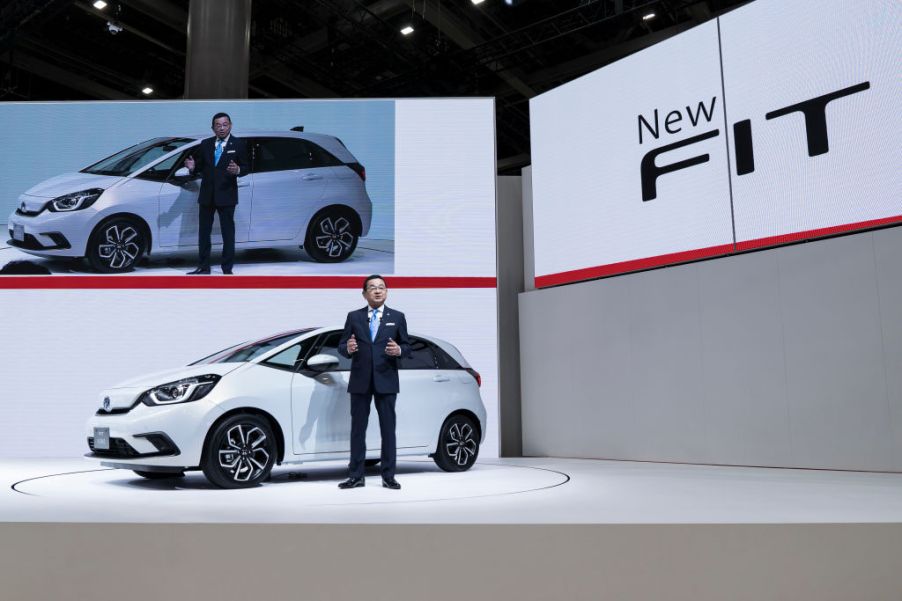
The Honda Fit Is Great if You Don’t Like Comfort
There is a reason they call cars like the Honda Fit “urban runabouts.” The word “urban” should be a clear enough hint toward the fact that subcompacts or B-segment superminis (the European term) aren’t designed for the long haul.
Sporty little cars like the Honda Fit and its cousin the Honda Jazz are perfect for big-city dwellers concerned with fitting in any available parking spot. The Fit is also great for navigating cramped city streets in places like Chicago where double parking is allowed; it’s a racy little vehicle ideal for anyone who doesn’t have a full family—young couples, retired couples, singles, or couples with one child. So, if the Fit isn’t comfortable, what good does it offer?
The Honda Fit received plenty of positive reviews
With an average listing price of $17,945 according to J.D. Power, the Honda Fit is one of the most affordable subcompacts on the market. The American-based data analytics and consumer intelligence company gave it a vehicle rating of 77 out of 100, which is one point higher than the 2018 model.
J.D. Power has six subcategories it uses to determine the overall score: quality, reliability, safety, experience, resale value, and dealer experience. Of those six subcategories, the Honda Fit’s resale value was rated 86 out of 100, making it the highest-scoring category.
U.S. News gave the Fit an overall score of 8.7 or “better than most” and listed it as the No. 1 subcompact car. The 2020 Mini Cooper made by BMW came second place with an overall score of 8.2 while the 2020 Kia Rio ranked No. 3 with an overall score of 8.1.
U.S. News pointed out several pros of the Fit including a versatile cargo hold with plenty of room, lots of available safety features, great fuel economy, as well as a spacious and well-designed cabin. The overall score was based on “45 pieces of research and data elements using various sources,” according to U.S. News.
Some reviewers seem to be at odds with themselves
Most reviews echo the same pros—sporty looks, spacious and flexible cabin, excellent fuel economy, and plenty of available safety features. However, the same reviews seem to also echo similar cons such as sluggish acceleration, cheap materials, flat and hard seats, and that it’s less fun to drive than previous models. And to be quite honest, if you were to read 10 Honda Fit reviews, you would likely find yourself confused.
For example, Car and Driver stated: “Cleanly styled and well assembled from quality materials, the Fit’s interior shines among the best in the segment. Factor in its spaciousness and the interior is a pleasant place to be,” but ” […] lacks the fun-to-drive personality of its predecessors […] ”
Toward the end of the article, the author wrote, “Of course, the hatch’s buzzy engine and some unspectacular interior materials bely its bargain pricing.”
Edward Loh of Automobile Magazine wrote: “In addition to making the seats more supportive and slimmer—thus reducing the separation between the front and rear occupants—and installing slick storage solutions, the Fit team focused on a ‘comfortable field of view.'”
Maybe by “supportive,” Loh was trying to allude to the seats being flat and hard. And is the Honda Fit’s interior “a pleasant place to be” or “unspectacular?”
You do have reviews published by websites like Consumer Reports that keep it short and to the point. It lauds the Fit for being an attractive urban runabout with excellent versatility, roomy interior, and great fuel economy.
However, it goes on to point out that the 2020 Honda Fit is like most other subcompacts in its limitations. When it came to comfort and convenience (ride, noise, front and rear seat comfort, interior fit and finish, and cargo area), CR gave the 2020 Fit some pretty low scores. The only areas in which the Fit received perfect scores were the transmission and fuel economy.
Is the Honda Fit worth the money?

Overall, when you consider how most subcompact cars feel, bad reviews here and there aren’t out of the question. As was stated by CR, “the 2020 Honda Fit is like most other subcompacts in its limitations.” Even modestly expensive sports cars that are supposed to be high-performance machines got bad reviews in 2020.
Take the $67,000 Alfa Romeo 4C which only received three stars from Car and Driver, stating that the “interior is poorly outfitted and cramped, there’s almost zero room for cargo, and you can forget about fancy infotainment features and driver-assistance tech.”
U.S. News published a review stating that the cabin of the 2020 Jaguar F-Type “isn’t as upscale and comfortable as many rivals” and has hard seats.
Of course, those are sports cars, and the Honda Fit isn’t even close to their class. But if Jaguar with its once-great répertoire found itself on the bad end of someone’s review, maybe 2020 is just one of those years. Nevertheless, the Honda Fit did exceptionally poor all the way around, even getting pummeled by Kia. At least the Romeo 4C and Jaguar F-Type offer a symbol of status while you’re hating their lackluster interiors.


